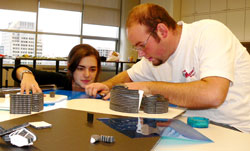Students redesign the Peel Basin with foam-core and imagination

Alina Gutierrez gets eye-level with the model she is working on with Julian Hakim. They were among 150 students who participated in a three-day intensive design competition.
photo by Marc Losier
Thirty Concordia students transformed piles of foam-core, acetate, wood and glue into maquettes and posters for a proposed redevelopment of the Peel Basin, an area in the vicinity of the Old Port. They were taking part in Charrette 2006, an annual, intensive three-day design competition among students from six universities sponsored by the Canadian Centre for Architecture.
“The excitement is about the idea of collaborating between different disciplines,” said Design Arts professor Rhona Richman Kenneally, referring to the innovative way this year’s Charrette was tackled by Concordia.
For the first time, students in the Department of Art History and the Department of Geography, Planning and Environment joined those in Design and Computation Arts to take up the challenge. Richman Kenneally has served as liaison to the CCA during the four years of Concordia’s Charrette participation, both on the committee that sets the design problem and as facilitator for participating students.
Charrette means cart in French. Architects use the term as a reference to the frantic last-minute work on their projects, while they are being driven in a charrette to the place where they were asked to deposit their proposal.
Pierre Gauthier, an assistant professor in Geography, Planning and Environment, supported Richman Kenneally in promoting the competition and helping the participating students.
“The Charrette offers a rare occasion for students interested in cities and city design to exchange ideas and share their expertise,” Gauthier said. To this end, Urban Studies graduate student Desmond Bliek, a member of one of the teams, also gave students an informal talk on the history of the site.
Lydia Karpenko, a third-year Design student, acknowledged the importance of interdisciplinary collaboration through the three days and sleepless nights she worked on the project with her team.
“We really needed help from urban planners, [because] we’d never done anything this huge. It was hard for us to imagine it.” Karpenko said the Charrette gave her a broader perspective as opposed to focusing on “small, specific things.”
Another collaborator, Art History professor Cynthia Hammond, said, “In my undergraduate class on architecture this term, students are being asked to think critically about the social responsibility of architecture versus its history of creative individualism.
“It was fantastic that the students in my class who participated got to experience something of that directly. On the one hand, they had the freedom to design an urban program in any way they chose. But at the same time, they were faced with the responsibility of deciding, however hypothetically, how the future residents and visitors to the site would experience it.”
This year, the twelfth edition was hosted by McGill. Architecture professor Peter Sijpkes proposed the challenge to develop the Peel Basin, which was publicly contested as the location for Casino de Montreal and Cirque du Soleil projects. Sijpkes has made the area his home for 30 years and is concerned about its future, especially with Wal-Mart eyeing the still-vacant site.
“I’m worried that because of laziness we will get the wrong type of building,” he said.
Sijpkes believes the creativity of over 150 students from Concordia, McGill, UQAM, Université de Montréal, Ryerson and Université Laval could contribute some fresh and original ideas to the public debate, turning the project into “sort of a preemptive strike.”
Charrette 2006 began on Oct. 26. The students had to hand in their projects at 6 p.m. the following Sunday. Université de Montréal students won the first prize and shared second prize with McGill students. Concordia shared the first prize in 2003.